System Analysis and Design
VerifiedAdded on 2023/06/04
|17
|3255
|302
AI Summary
This paper focuses on designing a high-level system architecture, discussing the various user design concepts, security concerns and controls, and the system deployment process for a human resource management system.
Contribute Materials
Your contribution can guide someone’s learning journey. Share your
documents today.

Running head: SYSTEM ANALYSIS AND DESIGN 1
System Analysis and Design
Student Name
Institutional Affiliation
System Analysis and Design
Student Name
Institutional Affiliation
Secure Best Marks with AI Grader
Need help grading? Try our AI Grader for instant feedback on your assignments.
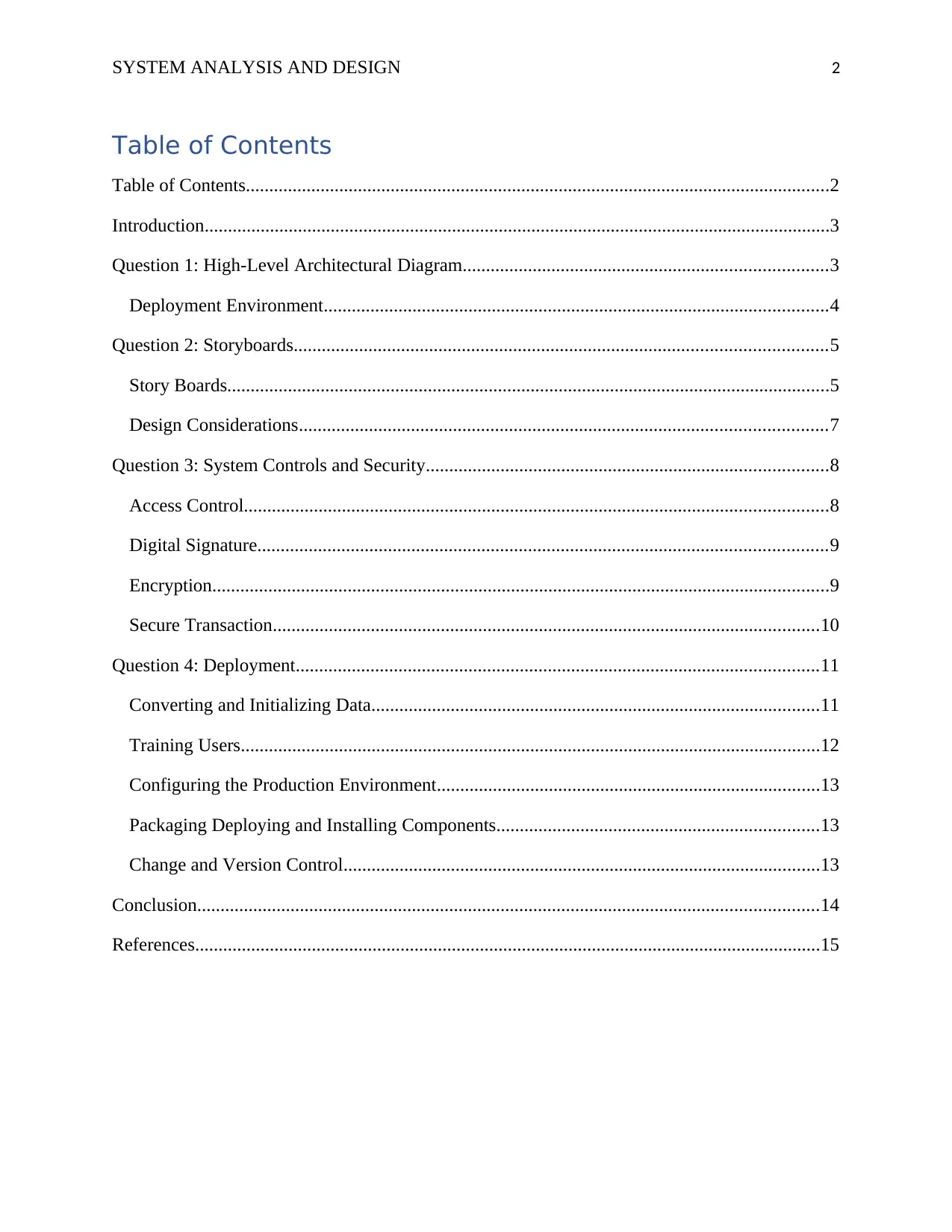
SYSTEM ANALYSIS AND DESIGN 2
Table of Contents
Table of Contents.............................................................................................................................2
Introduction......................................................................................................................................3
Question 1: High-Level Architectural Diagram..............................................................................3
Deployment Environment............................................................................................................4
Question 2: Storyboards..................................................................................................................5
Story Boards.................................................................................................................................5
Design Considerations.................................................................................................................7
Question 3: System Controls and Security......................................................................................8
Access Control.............................................................................................................................8
Digital Signature..........................................................................................................................9
Encryption....................................................................................................................................9
Secure Transaction.....................................................................................................................10
Question 4: Deployment................................................................................................................11
Converting and Initializing Data................................................................................................11
Training Users............................................................................................................................12
Configuring the Production Environment..................................................................................13
Packaging Deploying and Installing Components.....................................................................13
Change and Version Control......................................................................................................13
Conclusion.....................................................................................................................................14
References......................................................................................................................................15
Table of Contents
Table of Contents.............................................................................................................................2
Introduction......................................................................................................................................3
Question 1: High-Level Architectural Diagram..............................................................................3
Deployment Environment............................................................................................................4
Question 2: Storyboards..................................................................................................................5
Story Boards.................................................................................................................................5
Design Considerations.................................................................................................................7
Question 3: System Controls and Security......................................................................................8
Access Control.............................................................................................................................8
Digital Signature..........................................................................................................................9
Encryption....................................................................................................................................9
Secure Transaction.....................................................................................................................10
Question 4: Deployment................................................................................................................11
Converting and Initializing Data................................................................................................11
Training Users............................................................................................................................12
Configuring the Production Environment..................................................................................13
Packaging Deploying and Installing Components.....................................................................13
Change and Version Control......................................................................................................13
Conclusion.....................................................................................................................................14
References......................................................................................................................................15
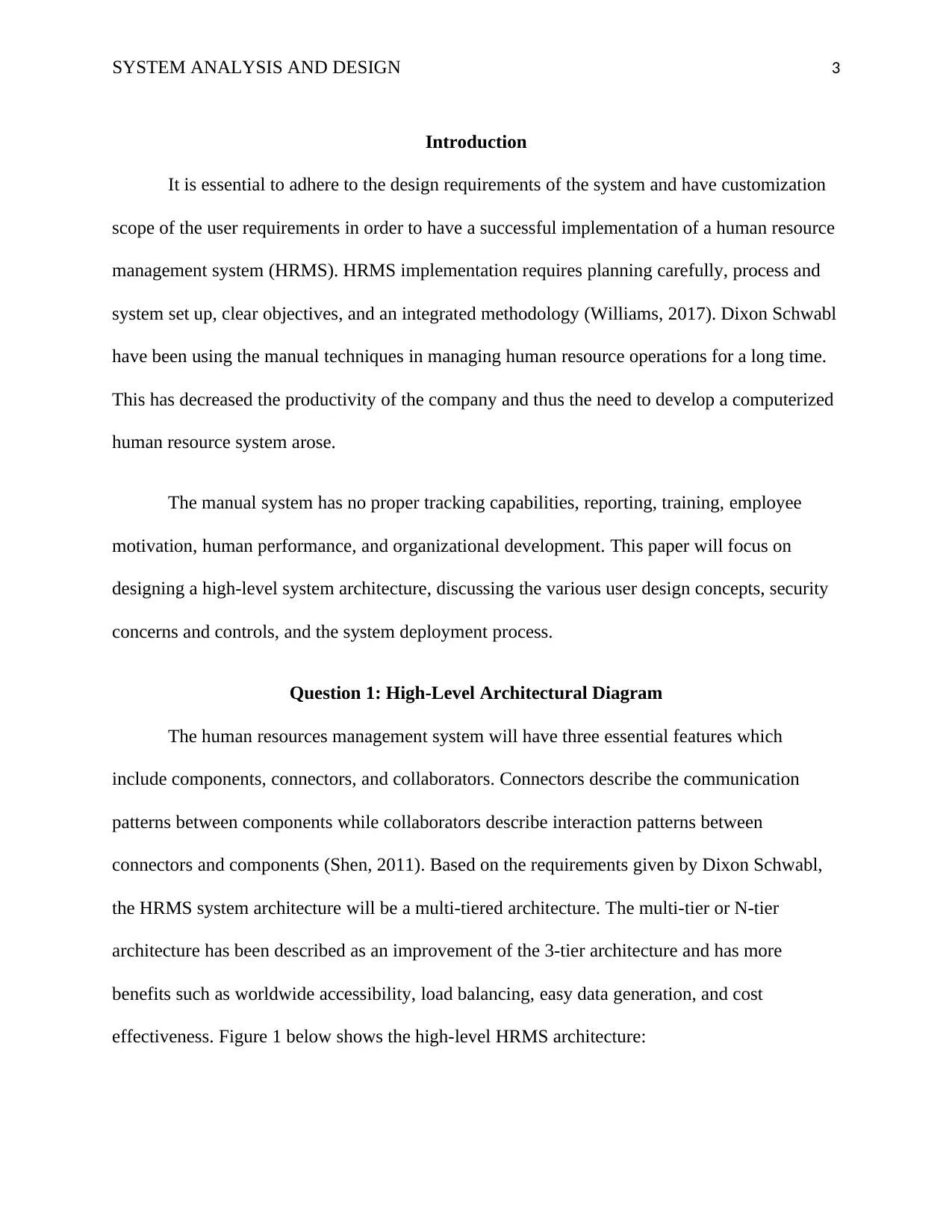
SYSTEM ANALYSIS AND DESIGN 3
Introduction
It is essential to adhere to the design requirements of the system and have customization
scope of the user requirements in order to have a successful implementation of a human resource
management system (HRMS). HRMS implementation requires planning carefully, process and
system set up, clear objectives, and an integrated methodology (Williams, 2017). Dixon Schwabl
have been using the manual techniques in managing human resource operations for a long time.
This has decreased the productivity of the company and thus the need to develop a computerized
human resource system arose.
The manual system has no proper tracking capabilities, reporting, training, employee
motivation, human performance, and organizational development. This paper will focus on
designing a high-level system architecture, discussing the various user design concepts, security
concerns and controls, and the system deployment process.
Question 1: High-Level Architectural Diagram
The human resources management system will have three essential features which
include components, connectors, and collaborators. Connectors describe the communication
patterns between components while collaborators describe interaction patterns between
connectors and components (Shen, 2011). Based on the requirements given by Dixon Schwabl,
the HRMS system architecture will be a multi-tiered architecture. The multi-tier or N-tier
architecture has been described as an improvement of the 3-tier architecture and has more
benefits such as worldwide accessibility, load balancing, easy data generation, and cost
effectiveness. Figure 1 below shows the high-level HRMS architecture:
Introduction
It is essential to adhere to the design requirements of the system and have customization
scope of the user requirements in order to have a successful implementation of a human resource
management system (HRMS). HRMS implementation requires planning carefully, process and
system set up, clear objectives, and an integrated methodology (Williams, 2017). Dixon Schwabl
have been using the manual techniques in managing human resource operations for a long time.
This has decreased the productivity of the company and thus the need to develop a computerized
human resource system arose.
The manual system has no proper tracking capabilities, reporting, training, employee
motivation, human performance, and organizational development. This paper will focus on
designing a high-level system architecture, discussing the various user design concepts, security
concerns and controls, and the system deployment process.
Question 1: High-Level Architectural Diagram
The human resources management system will have three essential features which
include components, connectors, and collaborators. Connectors describe the communication
patterns between components while collaborators describe interaction patterns between
connectors and components (Shen, 2011). Based on the requirements given by Dixon Schwabl,
the HRMS system architecture will be a multi-tiered architecture. The multi-tier or N-tier
architecture has been described as an improvement of the 3-tier architecture and has more
benefits such as worldwide accessibility, load balancing, easy data generation, and cost
effectiveness. Figure 1 below shows the high-level HRMS architecture:
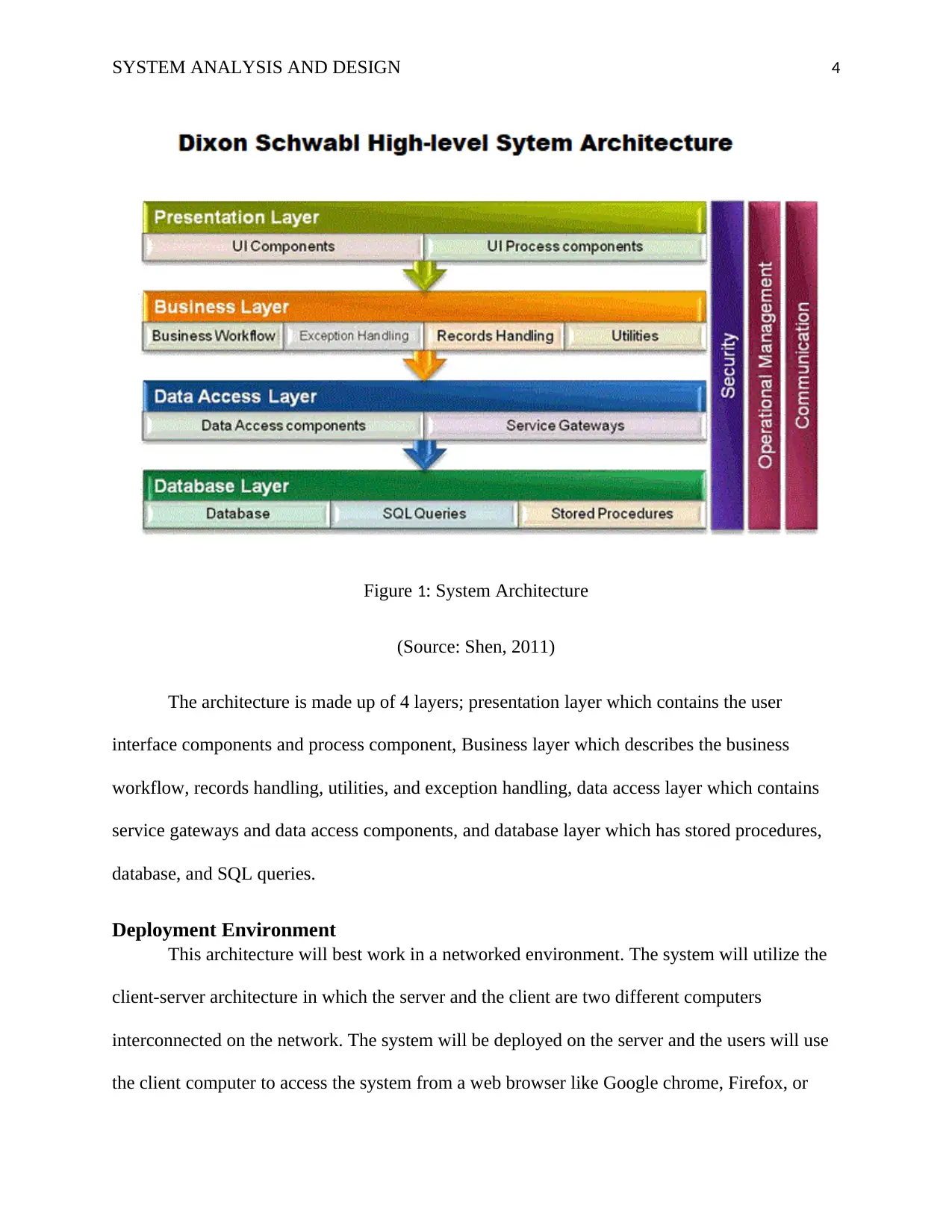
SYSTEM ANALYSIS AND DESIGN 4
Figure 1: System Architecture
(Source: Shen, 2011)
The architecture is made up of 4 layers; presentation layer which contains the user
interface components and process component, Business layer which describes the business
workflow, records handling, utilities, and exception handling, data access layer which contains
service gateways and data access components, and database layer which has stored procedures,
database, and SQL queries.
Deployment Environment
This architecture will best work in a networked environment. The system will utilize the
client-server architecture in which the server and the client are two different computers
interconnected on the network. The system will be deployed on the server and the users will use
the client computer to access the system from a web browser like Google chrome, Firefox, or
Figure 1: System Architecture
(Source: Shen, 2011)
The architecture is made up of 4 layers; presentation layer which contains the user
interface components and process component, Business layer which describes the business
workflow, records handling, utilities, and exception handling, data access layer which contains
service gateways and data access components, and database layer which has stored procedures,
database, and SQL queries.
Deployment Environment
This architecture will best work in a networked environment. The system will utilize the
client-server architecture in which the server and the client are two different computers
interconnected on the network. The system will be deployed on the server and the users will use
the client computer to access the system from a web browser like Google chrome, Firefox, or
Secure Best Marks with AI Grader
Need help grading? Try our AI Grader for instant feedback on your assignments.

SYSTEM ANALYSIS AND DESIGN 5
internet explorer. The client basically refers to a laptop, desktop, or a portable computing device
like a smartphone or tablet.
The server will store all the shared data. As compared to stand alone system, a networked
application is easy to manage through updates, patching, and adding security features to further
improve the security and performance of the application. The networked environment enables
sharing of resources where users have access to complete and up to date information, easy
communication, high reliability to ensure high system availability and minimal downtime, and
speed where users will be able to access the HRMS quickly (Yaskevich, 2017).
Question 2: Storyboards
Story Boards
The following storyboards shows the user interfaces that illustrates how the user interacts
with the various screens.
Figure 2: Add Employee Details
internet explorer. The client basically refers to a laptop, desktop, or a portable computing device
like a smartphone or tablet.
The server will store all the shared data. As compared to stand alone system, a networked
application is easy to manage through updates, patching, and adding security features to further
improve the security and performance of the application. The networked environment enables
sharing of resources where users have access to complete and up to date information, easy
communication, high reliability to ensure high system availability and minimal downtime, and
speed where users will be able to access the HRMS quickly (Yaskevich, 2017).
Question 2: Storyboards
Story Boards
The following storyboards shows the user interfaces that illustrates how the user interacts
with the various screens.
Figure 2: Add Employee Details

SYSTEM ANALYSIS AND DESIGN 6
The Human resources manager feels that the design is very appealing is able to add
details of the employee with a lot of ease. The interface is very intuitive and the form is very
easy to fill.
Figure 3: View Employee Details
The human resource manager can be able to view the details of the employees. The
interface also provides the functionality to edit the details or add any missing details.
Figure 4: View Employees
The Human resources manager feels that the design is very appealing is able to add
details of the employee with a lot of ease. The interface is very intuitive and the form is very
easy to fill.
Figure 3: View Employee Details
The human resource manager can be able to view the details of the employees. The
interface also provides the functionality to edit the details or add any missing details.
Figure 4: View Employees
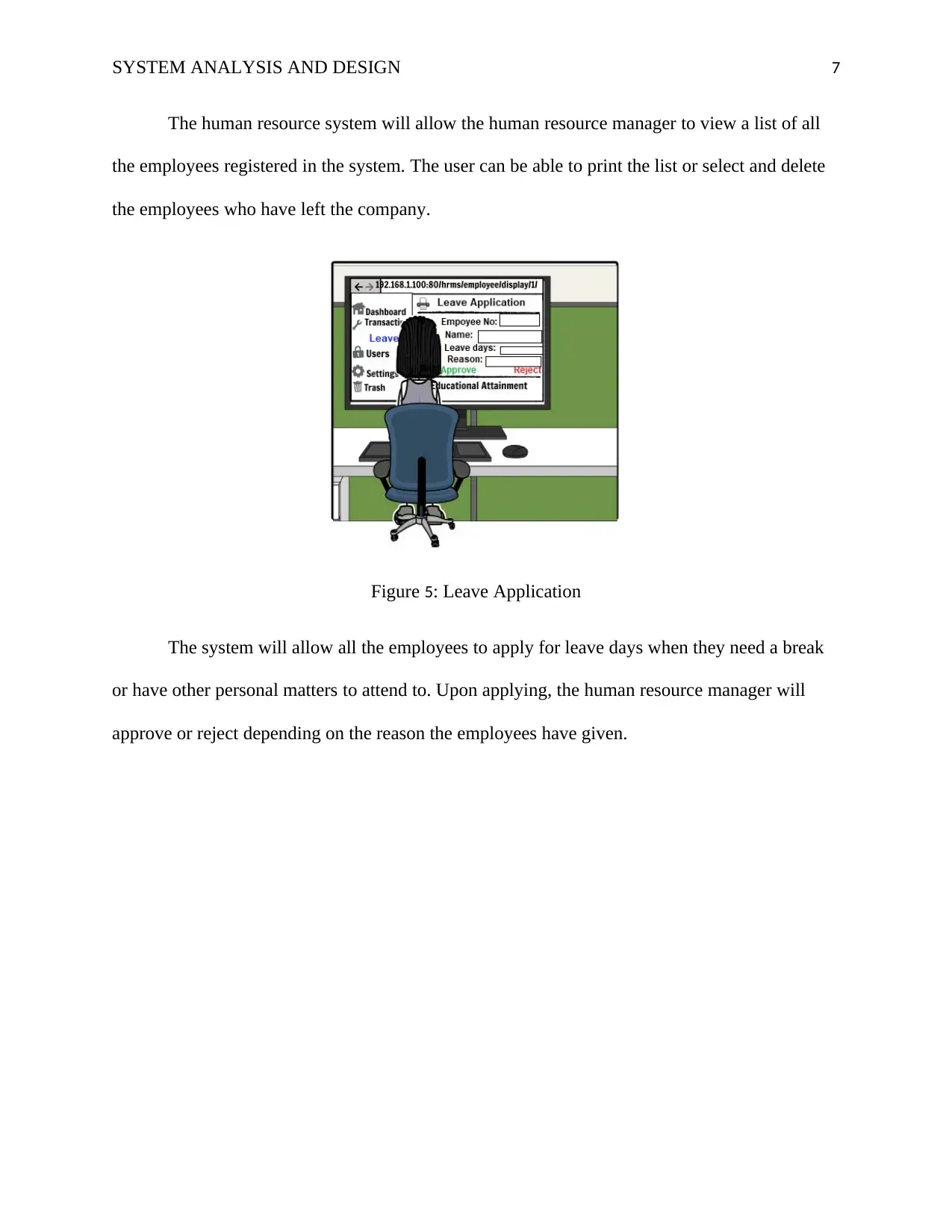
SYSTEM ANALYSIS AND DESIGN 7
The human resource system will allow the human resource manager to view a list of all
the employees registered in the system. The user can be able to print the list or select and delete
the employees who have left the company.
Figure 5: Leave Application
The system will allow all the employees to apply for leave days when they need a break
or have other personal matters to attend to. Upon applying, the human resource manager will
approve or reject depending on the reason the employees have given.
The human resource system will allow the human resource manager to view a list of all
the employees registered in the system. The user can be able to print the list or select and delete
the employees who have left the company.
Figure 5: Leave Application
The system will allow all the employees to apply for leave days when they need a break
or have other personal matters to attend to. Upon applying, the human resource manager will
approve or reject depending on the reason the employees have given.
Paraphrase This Document
Need a fresh take? Get an instant paraphrase of this document with our AI Paraphraser
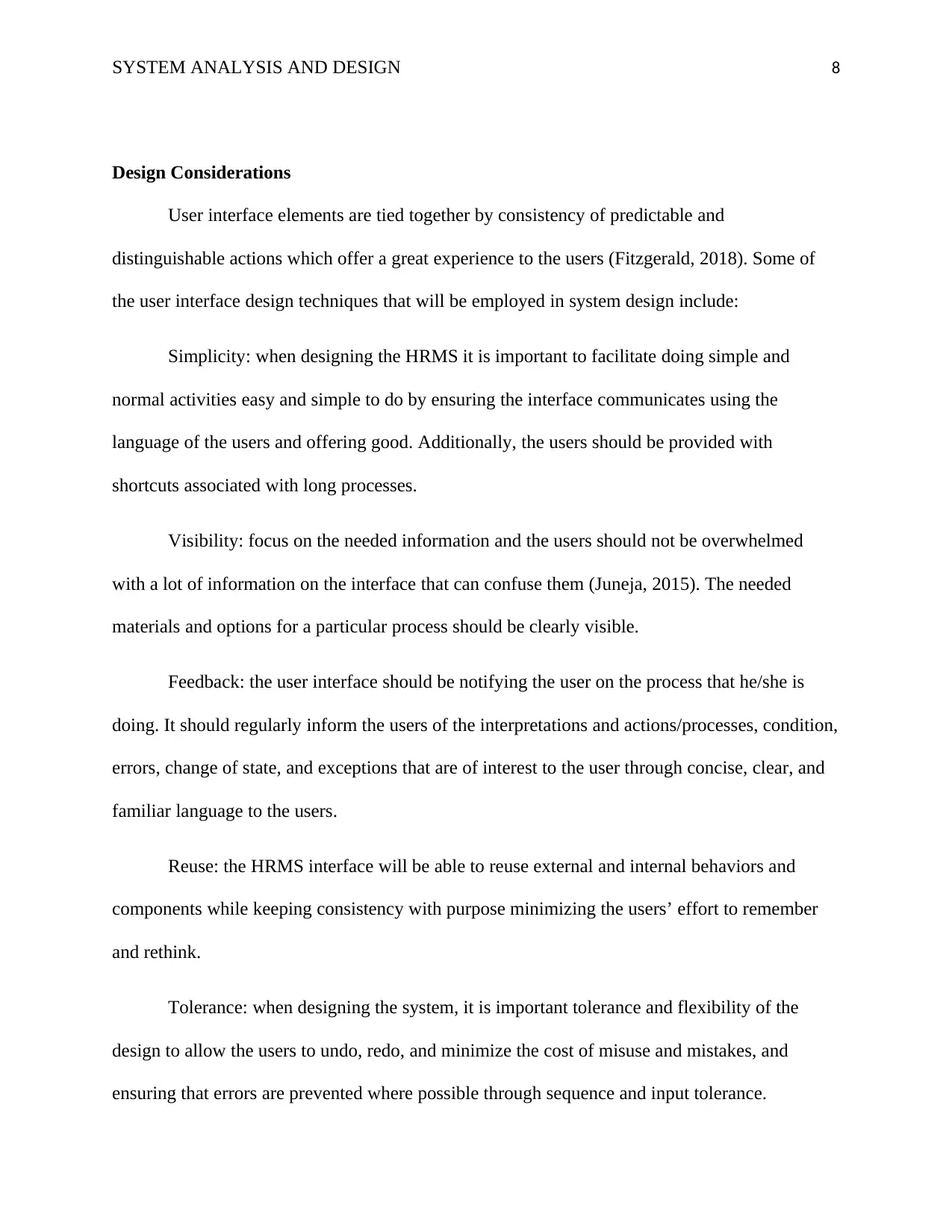
SYSTEM ANALYSIS AND DESIGN 8
Design Considerations
User interface elements are tied together by consistency of predictable and
distinguishable actions which offer a great experience to the users (Fitzgerald, 2018). Some of
the user interface design techniques that will be employed in system design include:
Simplicity: when designing the HRMS it is important to facilitate doing simple and
normal activities easy and simple to do by ensuring the interface communicates using the
language of the users and offering good. Additionally, the users should be provided with
shortcuts associated with long processes.
Visibility: focus on the needed information and the users should not be overwhelmed
with a lot of information on the interface that can confuse them (Juneja, 2015). The needed
materials and options for a particular process should be clearly visible.
Feedback: the user interface should be notifying the user on the process that he/she is
doing. It should regularly inform the users of the interpretations and actions/processes, condition,
errors, change of state, and exceptions that are of interest to the user through concise, clear, and
familiar language to the users.
Reuse: the HRMS interface will be able to reuse external and internal behaviors and
components while keeping consistency with purpose minimizing the users’ effort to remember
and rethink.
Tolerance: when designing the system, it is important tolerance and flexibility of the
design to allow the users to undo, redo, and minimize the cost of misuse and mistakes, and
ensuring that errors are prevented where possible through sequence and input tolerance.
Design Considerations
User interface elements are tied together by consistency of predictable and
distinguishable actions which offer a great experience to the users (Fitzgerald, 2018). Some of
the user interface design techniques that will be employed in system design include:
Simplicity: when designing the HRMS it is important to facilitate doing simple and
normal activities easy and simple to do by ensuring the interface communicates using the
language of the users and offering good. Additionally, the users should be provided with
shortcuts associated with long processes.
Visibility: focus on the needed information and the users should not be overwhelmed
with a lot of information on the interface that can confuse them (Juneja, 2015). The needed
materials and options for a particular process should be clearly visible.
Feedback: the user interface should be notifying the user on the process that he/she is
doing. It should regularly inform the users of the interpretations and actions/processes, condition,
errors, change of state, and exceptions that are of interest to the user through concise, clear, and
familiar language to the users.
Reuse: the HRMS interface will be able to reuse external and internal behaviors and
components while keeping consistency with purpose minimizing the users’ effort to remember
and rethink.
Tolerance: when designing the system, it is important tolerance and flexibility of the
design to allow the users to undo, redo, and minimize the cost of misuse and mistakes, and
ensuring that errors are prevented where possible through sequence and input tolerance.
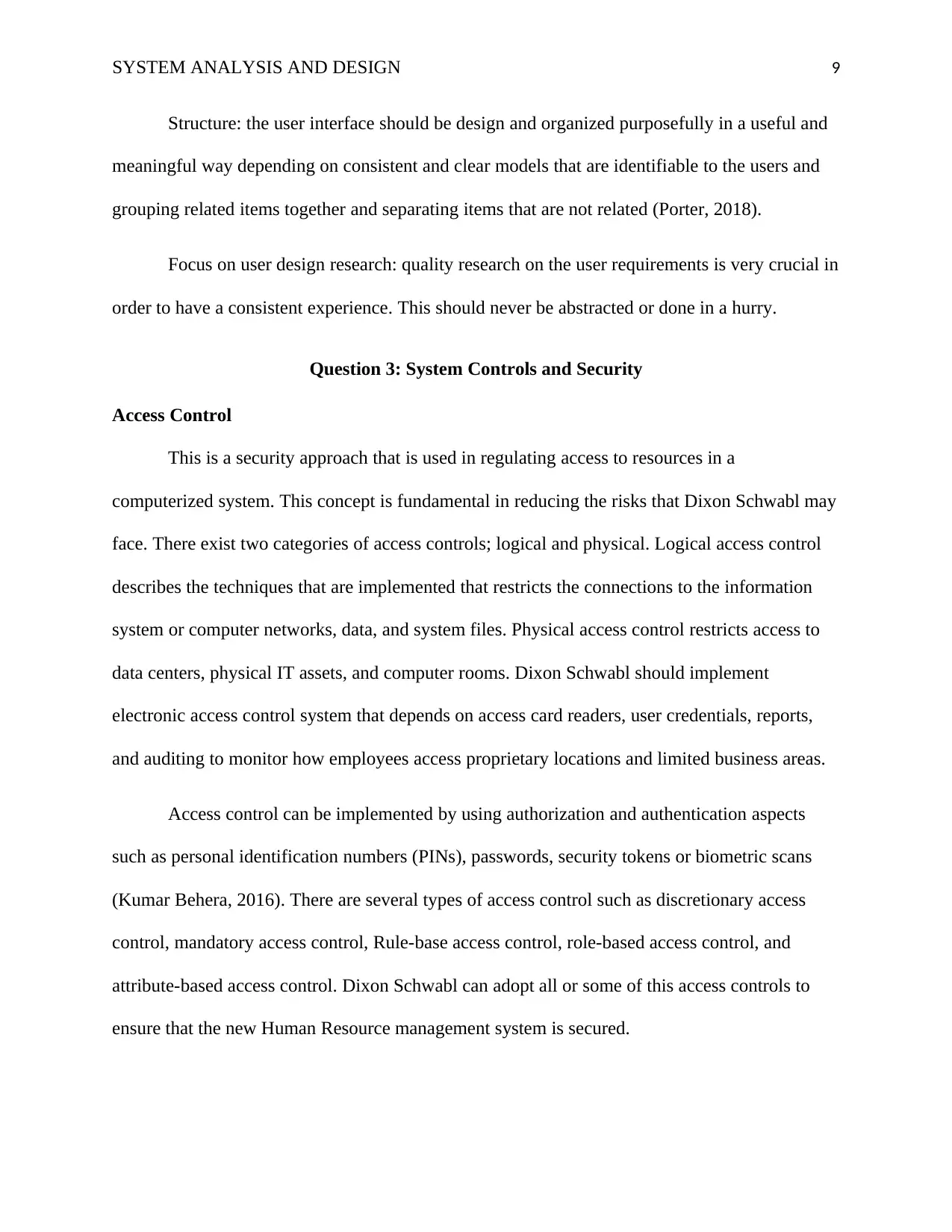
SYSTEM ANALYSIS AND DESIGN 9
Structure: the user interface should be design and organized purposefully in a useful and
meaningful way depending on consistent and clear models that are identifiable to the users and
grouping related items together and separating items that are not related (Porter, 2018).
Focus on user design research: quality research on the user requirements is very crucial in
order to have a consistent experience. This should never be abstracted or done in a hurry.
Question 3: System Controls and Security
Access Control
This is a security approach that is used in regulating access to resources in a
computerized system. This concept is fundamental in reducing the risks that Dixon Schwabl may
face. There exist two categories of access controls; logical and physical. Logical access control
describes the techniques that are implemented that restricts the connections to the information
system or computer networks, data, and system files. Physical access control restricts access to
data centers, physical IT assets, and computer rooms. Dixon Schwabl should implement
electronic access control system that depends on access card readers, user credentials, reports,
and auditing to monitor how employees access proprietary locations and limited business areas.
Access control can be implemented by using authorization and authentication aspects
such as personal identification numbers (PINs), passwords, security tokens or biometric scans
(Kumar Behera, 2016). There are several types of access control such as discretionary access
control, mandatory access control, Rule-base access control, role-based access control, and
attribute-based access control. Dixon Schwabl can adopt all or some of this access controls to
ensure that the new Human Resource management system is secured.
Structure: the user interface should be design and organized purposefully in a useful and
meaningful way depending on consistent and clear models that are identifiable to the users and
grouping related items together and separating items that are not related (Porter, 2018).
Focus on user design research: quality research on the user requirements is very crucial in
order to have a consistent experience. This should never be abstracted or done in a hurry.
Question 3: System Controls and Security
Access Control
This is a security approach that is used in regulating access to resources in a
computerized system. This concept is fundamental in reducing the risks that Dixon Schwabl may
face. There exist two categories of access controls; logical and physical. Logical access control
describes the techniques that are implemented that restricts the connections to the information
system or computer networks, data, and system files. Physical access control restricts access to
data centers, physical IT assets, and computer rooms. Dixon Schwabl should implement
electronic access control system that depends on access card readers, user credentials, reports,
and auditing to monitor how employees access proprietary locations and limited business areas.
Access control can be implemented by using authorization and authentication aspects
such as personal identification numbers (PINs), passwords, security tokens or biometric scans
(Kumar Behera, 2016). There are several types of access control such as discretionary access
control, mandatory access control, Rule-base access control, role-based access control, and
attribute-based access control. Dixon Schwabl can adopt all or some of this access controls to
ensure that the new Human Resource management system is secured.
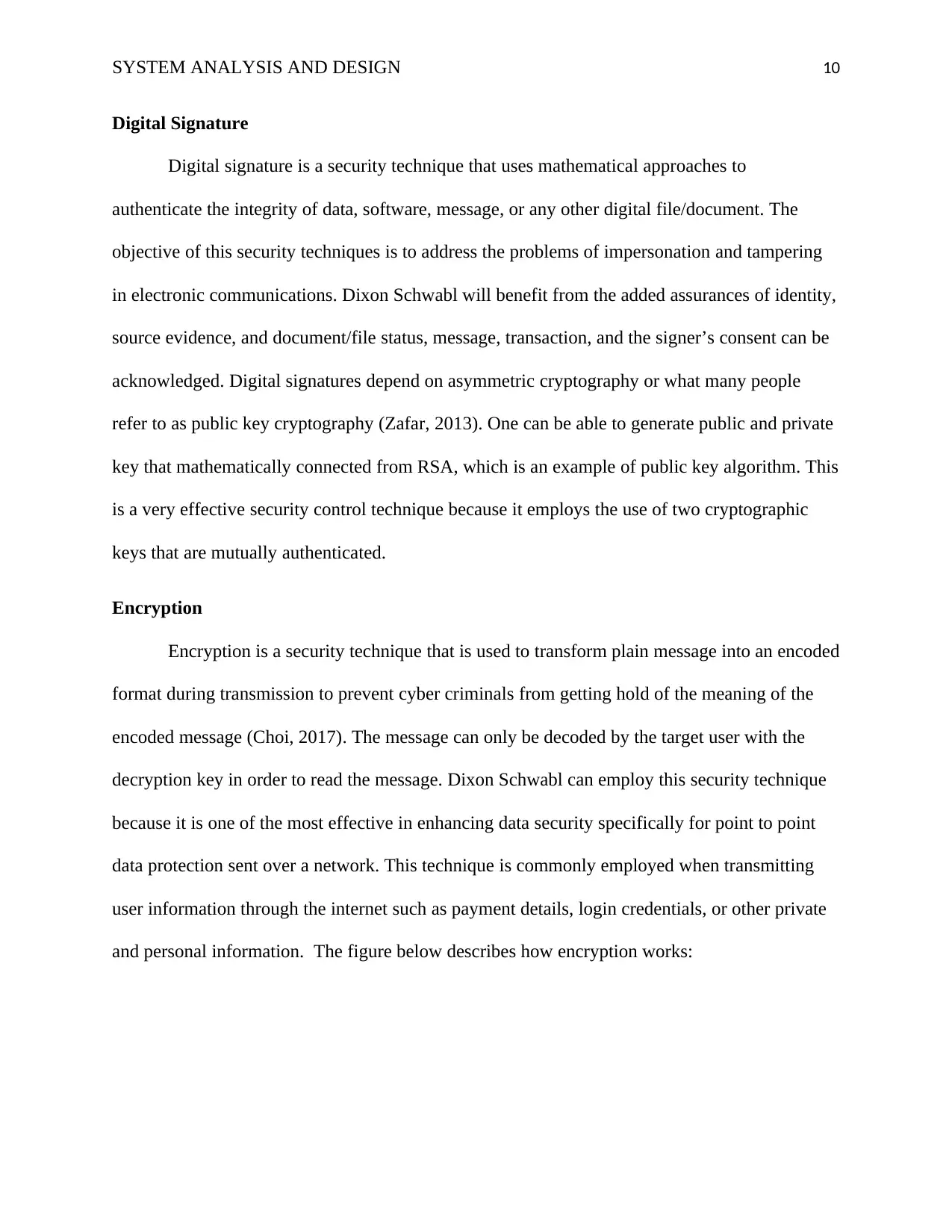
SYSTEM ANALYSIS AND DESIGN 10
Digital Signature
Digital signature is a security technique that uses mathematical approaches to
authenticate the integrity of data, software, message, or any other digital file/document. The
objective of this security techniques is to address the problems of impersonation and tampering
in electronic communications. Dixon Schwabl will benefit from the added assurances of identity,
source evidence, and document/file status, message, transaction, and the signer’s consent can be
acknowledged. Digital signatures depend on asymmetric cryptography or what many people
refer to as public key cryptography (Zafar, 2013). One can be able to generate public and private
key that mathematically connected from RSA, which is an example of public key algorithm. This
is a very effective security control technique because it employs the use of two cryptographic
keys that are mutually authenticated.
Encryption
Encryption is a security technique that is used to transform plain message into an encoded
format during transmission to prevent cyber criminals from getting hold of the meaning of the
encoded message (Choi, 2017). The message can only be decoded by the target user with the
decryption key in order to read the message. Dixon Schwabl can employ this security technique
because it is one of the most effective in enhancing data security specifically for point to point
data protection sent over a network. This technique is commonly employed when transmitting
user information through the internet such as payment details, login credentials, or other private
and personal information. The figure below describes how encryption works:
Digital Signature
Digital signature is a security technique that uses mathematical approaches to
authenticate the integrity of data, software, message, or any other digital file/document. The
objective of this security techniques is to address the problems of impersonation and tampering
in electronic communications. Dixon Schwabl will benefit from the added assurances of identity,
source evidence, and document/file status, message, transaction, and the signer’s consent can be
acknowledged. Digital signatures depend on asymmetric cryptography or what many people
refer to as public key cryptography (Zafar, 2013). One can be able to generate public and private
key that mathematically connected from RSA, which is an example of public key algorithm. This
is a very effective security control technique because it employs the use of two cryptographic
keys that are mutually authenticated.
Encryption
Encryption is a security technique that is used to transform plain message into an encoded
format during transmission to prevent cyber criminals from getting hold of the meaning of the
encoded message (Choi, 2017). The message can only be decoded by the target user with the
decryption key in order to read the message. Dixon Schwabl can employ this security technique
because it is one of the most effective in enhancing data security specifically for point to point
data protection sent over a network. This technique is commonly employed when transmitting
user information through the internet such as payment details, login credentials, or other private
and personal information. The figure below describes how encryption works:
Secure Best Marks with AI Grader
Need help grading? Try our AI Grader for instant feedback on your assignments.
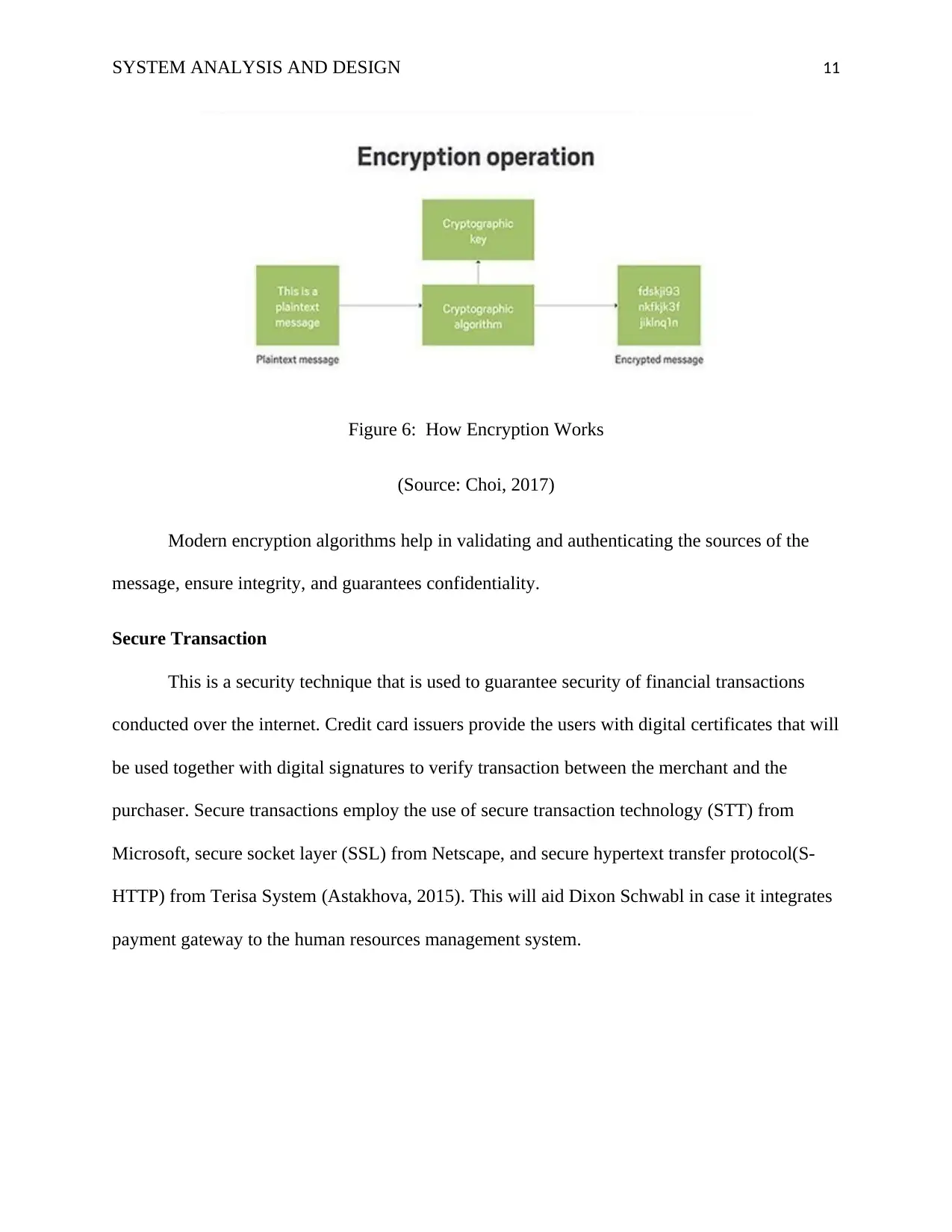
SYSTEM ANALYSIS AND DESIGN 11
Figure 6: How Encryption Works
(Source: Choi, 2017)
Modern encryption algorithms help in validating and authenticating the sources of the
message, ensure integrity, and guarantees confidentiality.
Secure Transaction
This is a security technique that is used to guarantee security of financial transactions
conducted over the internet. Credit card issuers provide the users with digital certificates that will
be used together with digital signatures to verify transaction between the merchant and the
purchaser. Secure transactions employ the use of secure transaction technology (STT) from
Microsoft, secure socket layer (SSL) from Netscape, and secure hypertext transfer protocol(S-
HTTP) from Terisa System (Astakhova, 2015). This will aid Dixon Schwabl in case it integrates
payment gateway to the human resources management system.
Figure 6: How Encryption Works
(Source: Choi, 2017)
Modern encryption algorithms help in validating and authenticating the sources of the
message, ensure integrity, and guarantees confidentiality.
Secure Transaction
This is a security technique that is used to guarantee security of financial transactions
conducted over the internet. Credit card issuers provide the users with digital certificates that will
be used together with digital signatures to verify transaction between the merchant and the
purchaser. Secure transactions employ the use of secure transaction technology (STT) from
Microsoft, secure socket layer (SSL) from Netscape, and secure hypertext transfer protocol(S-
HTTP) from Terisa System (Astakhova, 2015). This will aid Dixon Schwabl in case it integrates
payment gateway to the human resources management system.
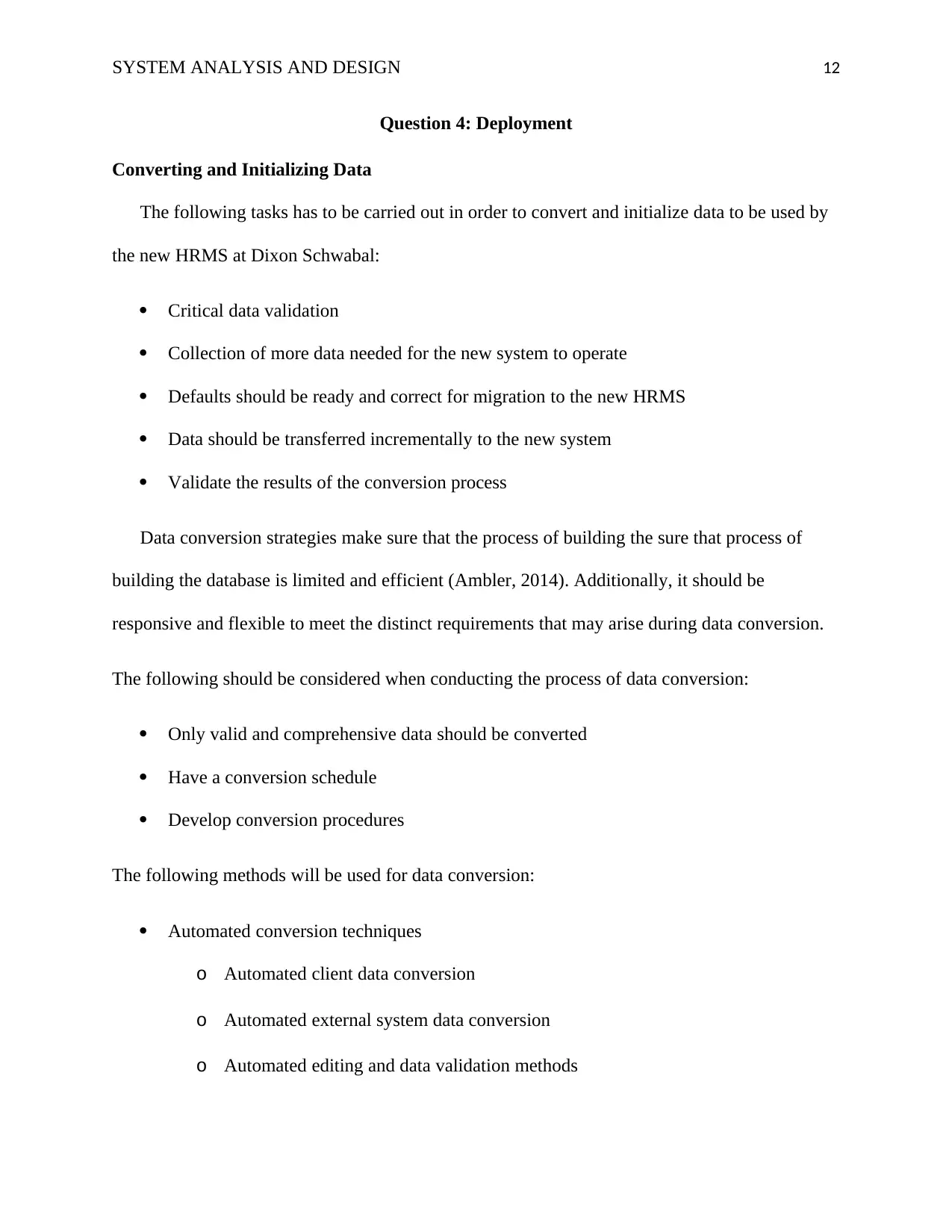
SYSTEM ANALYSIS AND DESIGN 12
Question 4: Deployment
Converting and Initializing Data
The following tasks has to be carried out in order to convert and initialize data to be used by
the new HRMS at Dixon Schwabal:
Critical data validation
Collection of more data needed for the new system to operate
Defaults should be ready and correct for migration to the new HRMS
Data should be transferred incrementally to the new system
Validate the results of the conversion process
Data conversion strategies make sure that the process of building the sure that process of
building the database is limited and efficient (Ambler, 2014). Additionally, it should be
responsive and flexible to meet the distinct requirements that may arise during data conversion.
The following should be considered when conducting the process of data conversion:
Only valid and comprehensive data should be converted
Have a conversion schedule
Develop conversion procedures
The following methods will be used for data conversion:
Automated conversion techniques
o Automated client data conversion
o Automated external system data conversion
o Automated editing and data validation methods
Question 4: Deployment
Converting and Initializing Data
The following tasks has to be carried out in order to convert and initialize data to be used by
the new HRMS at Dixon Schwabal:
Critical data validation
Collection of more data needed for the new system to operate
Defaults should be ready and correct for migration to the new HRMS
Data should be transferred incrementally to the new system
Validate the results of the conversion process
Data conversion strategies make sure that the process of building the sure that process of
building the database is limited and efficient (Ambler, 2014). Additionally, it should be
responsive and flexible to meet the distinct requirements that may arise during data conversion.
The following should be considered when conducting the process of data conversion:
Only valid and comprehensive data should be converted
Have a conversion schedule
Develop conversion procedures
The following methods will be used for data conversion:
Automated conversion techniques
o Automated client data conversion
o Automated external system data conversion
o Automated editing and data validation methods
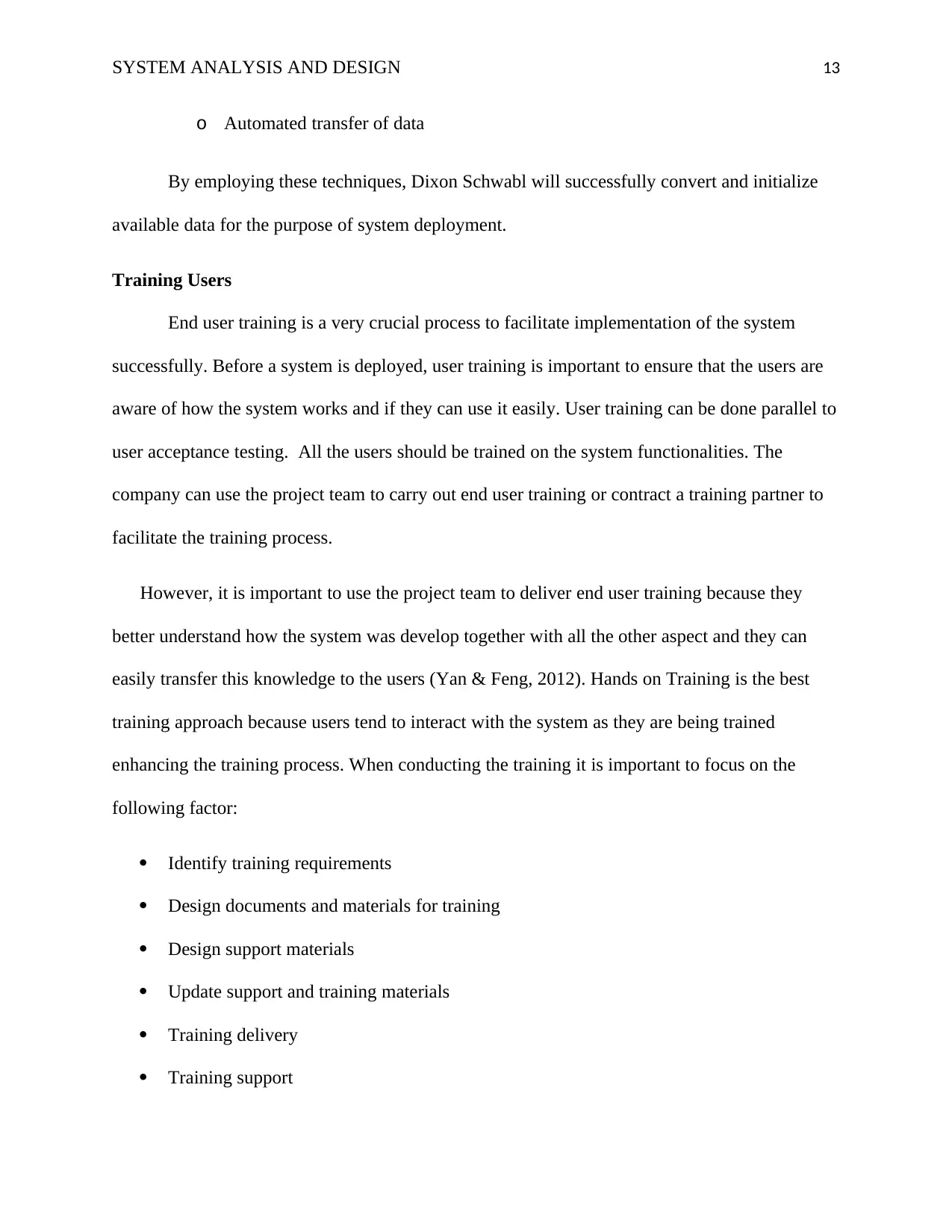
SYSTEM ANALYSIS AND DESIGN 13
o Automated transfer of data
By employing these techniques, Dixon Schwabl will successfully convert and initialize
available data for the purpose of system deployment.
Training Users
End user training is a very crucial process to facilitate implementation of the system
successfully. Before a system is deployed, user training is important to ensure that the users are
aware of how the system works and if they can use it easily. User training can be done parallel to
user acceptance testing. All the users should be trained on the system functionalities. The
company can use the project team to carry out end user training or contract a training partner to
facilitate the training process.
However, it is important to use the project team to deliver end user training because they
better understand how the system was develop together with all the other aspect and they can
easily transfer this knowledge to the users (Yan & Feng, 2012). Hands on Training is the best
training approach because users tend to interact with the system as they are being trained
enhancing the training process. When conducting the training it is important to focus on the
following factor:
Identify training requirements
Design documents and materials for training
Design support materials
Update support and training materials
Training delivery
Training support
o Automated transfer of data
By employing these techniques, Dixon Schwabl will successfully convert and initialize
available data for the purpose of system deployment.
Training Users
End user training is a very crucial process to facilitate implementation of the system
successfully. Before a system is deployed, user training is important to ensure that the users are
aware of how the system works and if they can use it easily. User training can be done parallel to
user acceptance testing. All the users should be trained on the system functionalities. The
company can use the project team to carry out end user training or contract a training partner to
facilitate the training process.
However, it is important to use the project team to deliver end user training because they
better understand how the system was develop together with all the other aspect and they can
easily transfer this knowledge to the users (Yan & Feng, 2012). Hands on Training is the best
training approach because users tend to interact with the system as they are being trained
enhancing the training process. When conducting the training it is important to focus on the
following factor:
Identify training requirements
Design documents and materials for training
Design support materials
Update support and training materials
Training delivery
Training support
Paraphrase This Document
Need a fresh take? Get an instant paraphrase of this document with our AI Paraphraser

SYSTEM ANALYSIS AND DESIGN 14
Configuring the Production Environment
HRMS implementation is basically an integrated and planned approach involving the HR
managers, executive management and a team of technical specialists and consultants. A clear
definition of organizational goals and objectives is very important before starting the
implementation module
The implementation basis is the planning on which the probability of successful
implementation relies. It offers the foundation for the choice of project consultant or manager,
defining management and reports methods, functional areas, comparing and assessing future and
current processes, modify modernized methods, selecting a particular project, a good team of
implementation, budgetary techniques, software and hardware determination, communication of
user and software acceptance (Khera, 2012).
Packaging Deploying and Installing Components
Before fully deploying the system, it is important to ensure that the critical components needed
to deploy the system are in place. They include:
Set up the network infrastructure
Implement security procedures and access control
Set up servers
Configure database
When all these components have been deployed and installed, the HRMS can be deployed.
Change and Version Control
Although there are many change and version processes, the following are the general
activities:
Configuring the Production Environment
HRMS implementation is basically an integrated and planned approach involving the HR
managers, executive management and a team of technical specialists and consultants. A clear
definition of organizational goals and objectives is very important before starting the
implementation module
The implementation basis is the planning on which the probability of successful
implementation relies. It offers the foundation for the choice of project consultant or manager,
defining management and reports methods, functional areas, comparing and assessing future and
current processes, modify modernized methods, selecting a particular project, a good team of
implementation, budgetary techniques, software and hardware determination, communication of
user and software acceptance (Khera, 2012).
Packaging Deploying and Installing Components
Before fully deploying the system, it is important to ensure that the critical components needed
to deploy the system are in place. They include:
Set up the network infrastructure
Implement security procedures and access control
Set up servers
Configure database
When all these components have been deployed and installed, the HRMS can be deployed.
Change and Version Control
Although there are many change and version processes, the following are the general
activities:
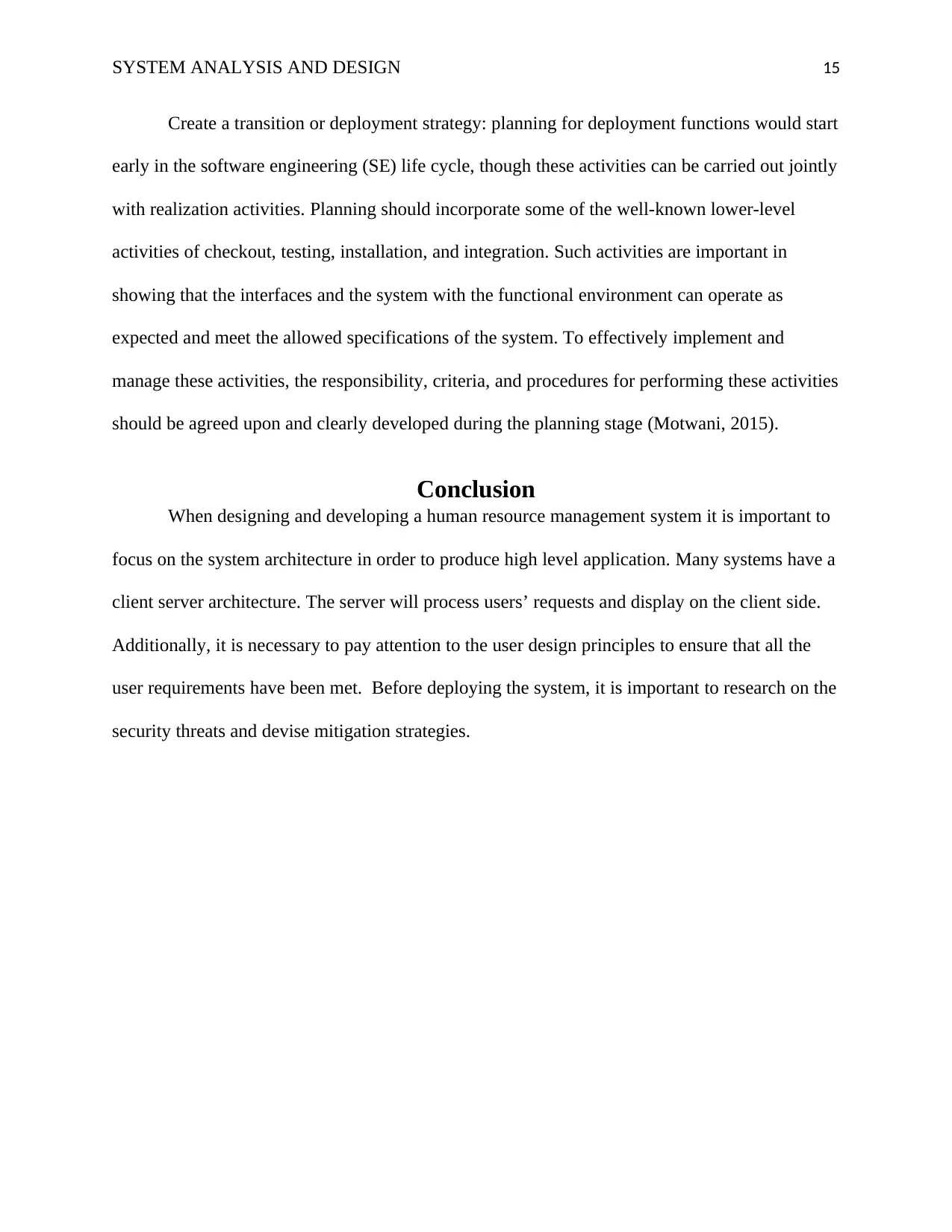
SYSTEM ANALYSIS AND DESIGN 15
Create a transition or deployment strategy: planning for deployment functions would start
early in the software engineering (SE) life cycle, though these activities can be carried out jointly
with realization activities. Planning should incorporate some of the well-known lower-level
activities of checkout, testing, installation, and integration. Such activities are important in
showing that the interfaces and the system with the functional environment can operate as
expected and meet the allowed specifications of the system. To effectively implement and
manage these activities, the responsibility, criteria, and procedures for performing these activities
should be agreed upon and clearly developed during the planning stage (Motwani, 2015).
Conclusion
When designing and developing a human resource management system it is important to
focus on the system architecture in order to produce high level application. Many systems have a
client server architecture. The server will process users’ requests and display on the client side.
Additionally, it is necessary to pay attention to the user design principles to ensure that all the
user requirements have been met. Before deploying the system, it is important to research on the
security threats and devise mitigation strategies.
Create a transition or deployment strategy: planning for deployment functions would start
early in the software engineering (SE) life cycle, though these activities can be carried out jointly
with realization activities. Planning should incorporate some of the well-known lower-level
activities of checkout, testing, installation, and integration. Such activities are important in
showing that the interfaces and the system with the functional environment can operate as
expected and meet the allowed specifications of the system. To effectively implement and
manage these activities, the responsibility, criteria, and procedures for performing these activities
should be agreed upon and clearly developed during the planning stage (Motwani, 2015).
Conclusion
When designing and developing a human resource management system it is important to
focus on the system architecture in order to produce high level application. Many systems have a
client server architecture. The server will process users’ requests and display on the client side.
Additionally, it is necessary to pay attention to the user design principles to ensure that all the
user requirements have been met. Before deploying the system, it is important to research on the
security threats and devise mitigation strategies.
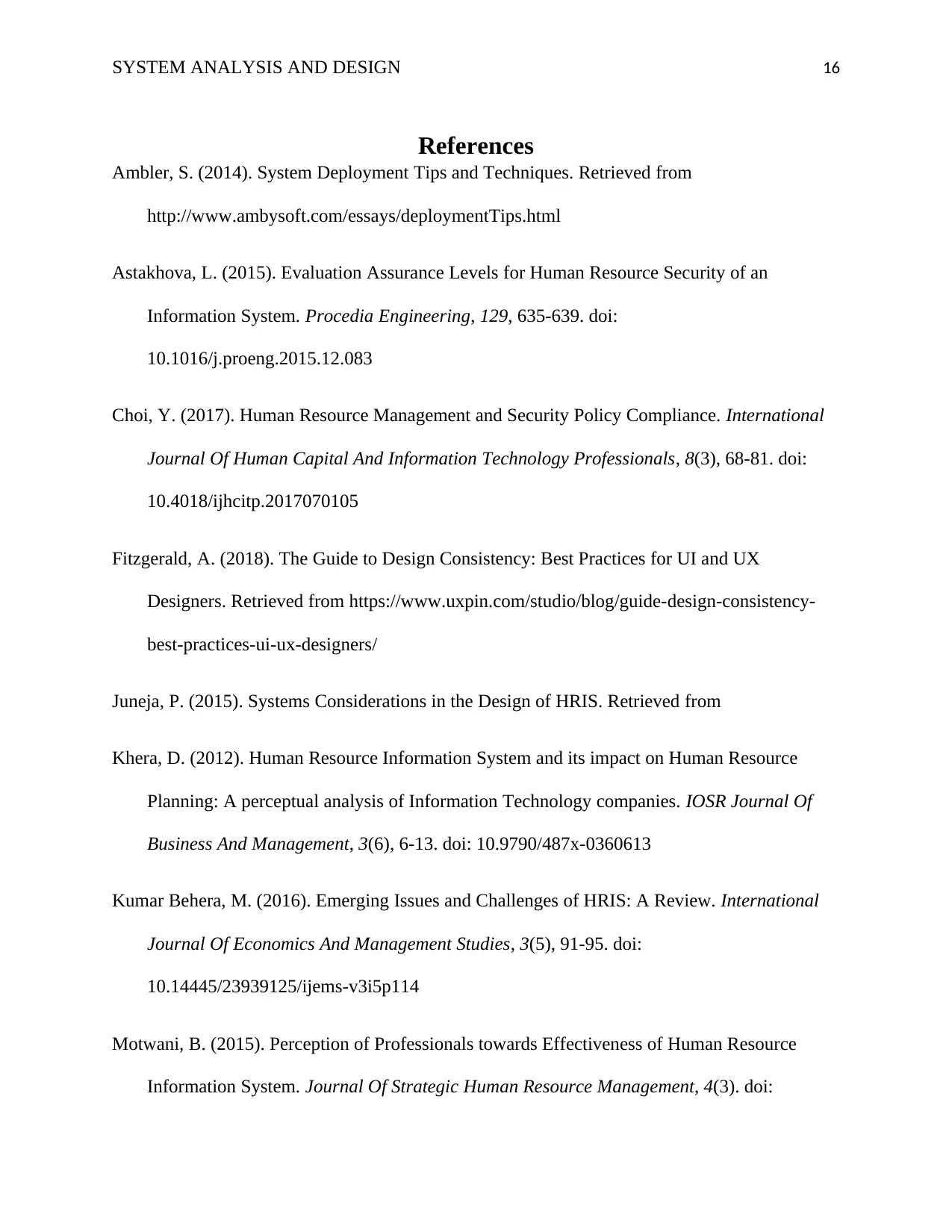
SYSTEM ANALYSIS AND DESIGN 16
References
Ambler, S. (2014). System Deployment Tips and Techniques. Retrieved from
http://www.ambysoft.com/essays/deploymentTips.html
Astakhova, L. (2015). Evaluation Assurance Levels for Human Resource Security of an
Information System. Procedia Engineering, 129, 635-639. doi:
10.1016/j.proeng.2015.12.083
Choi, Y. (2017). Human Resource Management and Security Policy Compliance. International
Journal Of Human Capital And Information Technology Professionals, 8(3), 68-81. doi:
10.4018/ijhcitp.2017070105
Fitzgerald, A. (2018). The Guide to Design Consistency: Best Practices for UI and UX
Designers. Retrieved from https://www.uxpin.com/studio/blog/guide-design-consistency-
best-practices-ui-ux-designers/
Juneja, P. (2015). Systems Considerations in the Design of HRIS. Retrieved from
Khera, D. (2012). Human Resource Information System and its impact on Human Resource
Planning: A perceptual analysis of Information Technology companies. IOSR Journal Of
Business And Management, 3(6), 6-13. doi: 10.9790/487x-0360613
Kumar Behera, M. (2016). Emerging Issues and Challenges of HRIS: A Review. International
Journal Of Economics And Management Studies, 3(5), 91-95. doi:
10.14445/23939125/ijems-v3i5p114
Motwani, B. (2015). Perception of Professionals towards Effectiveness of Human Resource
Information System. Journal Of Strategic Human Resource Management, 4(3). doi:
References
Ambler, S. (2014). System Deployment Tips and Techniques. Retrieved from
http://www.ambysoft.com/essays/deploymentTips.html
Astakhova, L. (2015). Evaluation Assurance Levels for Human Resource Security of an
Information System. Procedia Engineering, 129, 635-639. doi:
10.1016/j.proeng.2015.12.083
Choi, Y. (2017). Human Resource Management and Security Policy Compliance. International
Journal Of Human Capital And Information Technology Professionals, 8(3), 68-81. doi:
10.4018/ijhcitp.2017070105
Fitzgerald, A. (2018). The Guide to Design Consistency: Best Practices for UI and UX
Designers. Retrieved from https://www.uxpin.com/studio/blog/guide-design-consistency-
best-practices-ui-ux-designers/
Juneja, P. (2015). Systems Considerations in the Design of HRIS. Retrieved from
Khera, D. (2012). Human Resource Information System and its impact on Human Resource
Planning: A perceptual analysis of Information Technology companies. IOSR Journal Of
Business And Management, 3(6), 6-13. doi: 10.9790/487x-0360613
Kumar Behera, M. (2016). Emerging Issues and Challenges of HRIS: A Review. International
Journal Of Economics And Management Studies, 3(5), 91-95. doi:
10.14445/23939125/ijems-v3i5p114
Motwani, B. (2015). Perception of Professionals towards Effectiveness of Human Resource
Information System. Journal Of Strategic Human Resource Management, 4(3). doi:
Secure Best Marks with AI Grader
Need help grading? Try our AI Grader for instant feedback on your assignments.
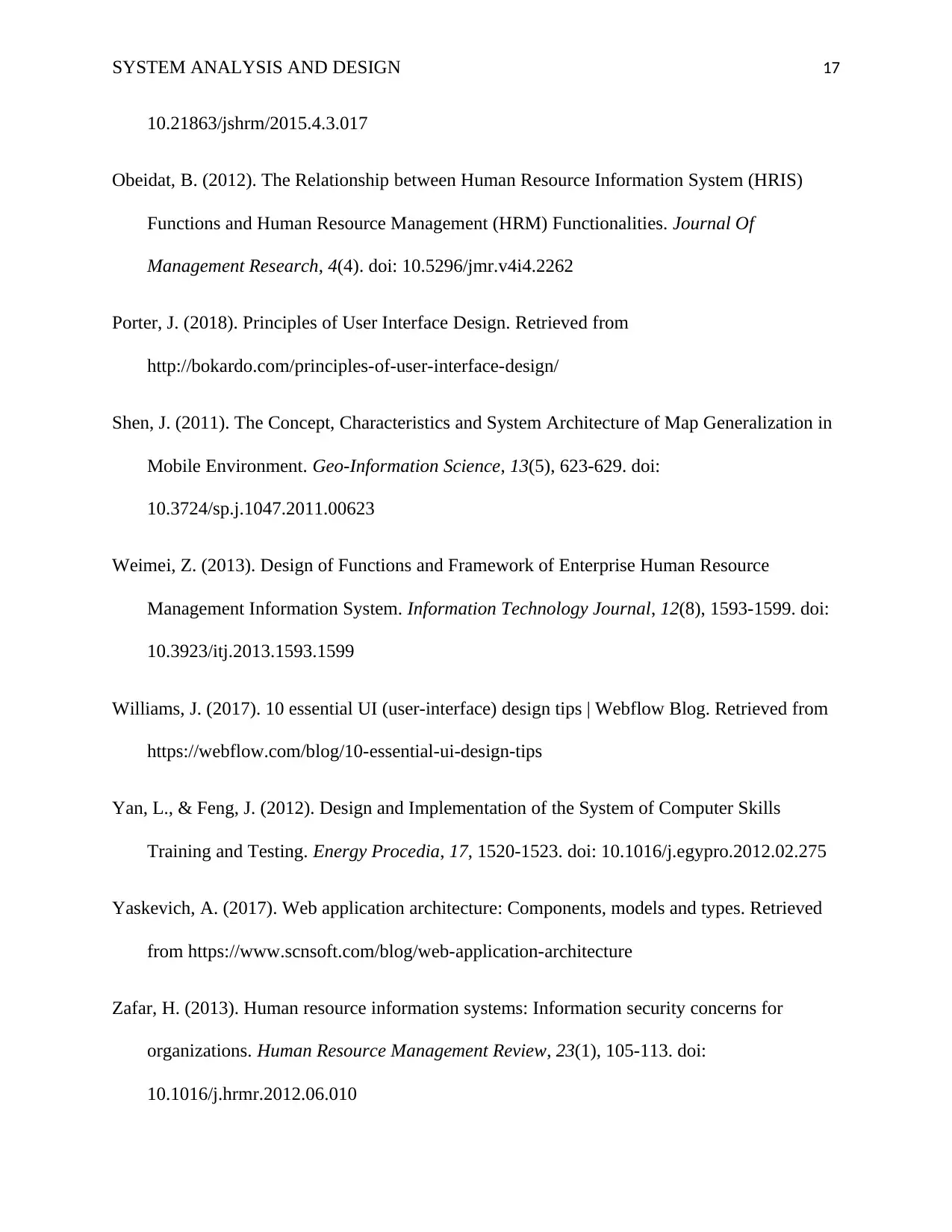
SYSTEM ANALYSIS AND DESIGN 17
10.21863/jshrm/2015.4.3.017
Obeidat, B. (2012). The Relationship between Human Resource Information System (HRIS)
Functions and Human Resource Management (HRM) Functionalities. Journal Of
Management Research, 4(4). doi: 10.5296/jmr.v4i4.2262
Porter, J. (2018). Principles of User Interface Design. Retrieved from
http://bokardo.com/principles-of-user-interface-design/
Shen, J. (2011). The Concept, Characteristics and System Architecture of Map Generalization in
Mobile Environment. Geo-Information Science, 13(5), 623-629. doi:
10.3724/sp.j.1047.2011.00623
Weimei, Z. (2013). Design of Functions and Framework of Enterprise Human Resource
Management Information System. Information Technology Journal, 12(8), 1593-1599. doi:
10.3923/itj.2013.1593.1599
Williams, J. (2017). 10 essential UI (user-interface) design tips | Webflow Blog. Retrieved from
https://webflow.com/blog/10-essential-ui-design-tips
Yan, L., & Feng, J. (2012). Design and Implementation of the System of Computer Skills
Training and Testing. Energy Procedia, 17, 1520-1523. doi: 10.1016/j.egypro.2012.02.275
Yaskevich, A. (2017). Web application architecture: Components, models and types. Retrieved
from https://www.scnsoft.com/blog/web-application-architecture
Zafar, H. (2013). Human resource information systems: Information security concerns for
organizations. Human Resource Management Review, 23(1), 105-113. doi:
10.1016/j.hrmr.2012.06.010
10.21863/jshrm/2015.4.3.017
Obeidat, B. (2012). The Relationship between Human Resource Information System (HRIS)
Functions and Human Resource Management (HRM) Functionalities. Journal Of
Management Research, 4(4). doi: 10.5296/jmr.v4i4.2262
Porter, J. (2018). Principles of User Interface Design. Retrieved from
http://bokardo.com/principles-of-user-interface-design/
Shen, J. (2011). The Concept, Characteristics and System Architecture of Map Generalization in
Mobile Environment. Geo-Information Science, 13(5), 623-629. doi:
10.3724/sp.j.1047.2011.00623
Weimei, Z. (2013). Design of Functions and Framework of Enterprise Human Resource
Management Information System. Information Technology Journal, 12(8), 1593-1599. doi:
10.3923/itj.2013.1593.1599
Williams, J. (2017). 10 essential UI (user-interface) design tips | Webflow Blog. Retrieved from
https://webflow.com/blog/10-essential-ui-design-tips
Yan, L., & Feng, J. (2012). Design and Implementation of the System of Computer Skills
Training and Testing. Energy Procedia, 17, 1520-1523. doi: 10.1016/j.egypro.2012.02.275
Yaskevich, A. (2017). Web application architecture: Components, models and types. Retrieved
from https://www.scnsoft.com/blog/web-application-architecture
Zafar, H. (2013). Human resource information systems: Information security concerns for
organizations. Human Resource Management Review, 23(1), 105-113. doi:
10.1016/j.hrmr.2012.06.010
1 out of 17
Related Documents
Your All-in-One AI-Powered Toolkit for Academic Success.
+13062052269
info@desklib.com
Available 24*7 on WhatsApp / Email
![[object Object]](/_next/static/media/star-bottom.7253800d.svg)
Unlock your academic potential
© 2024 | Zucol Services PVT LTD | All rights reserved.





